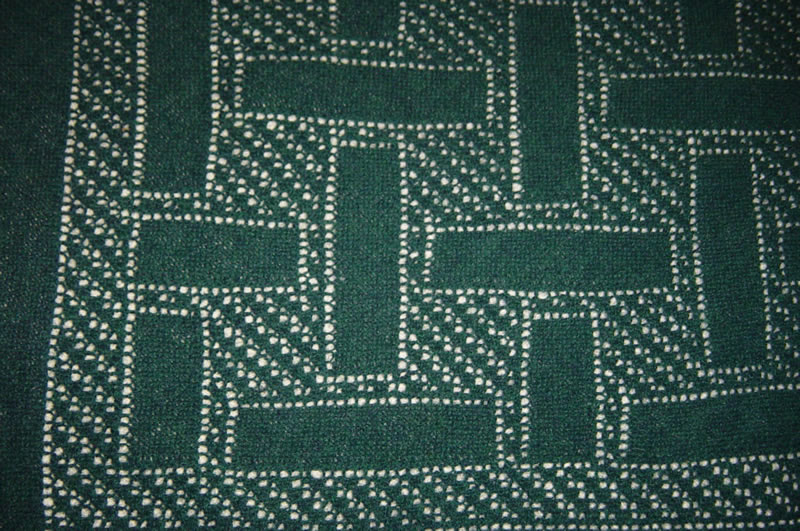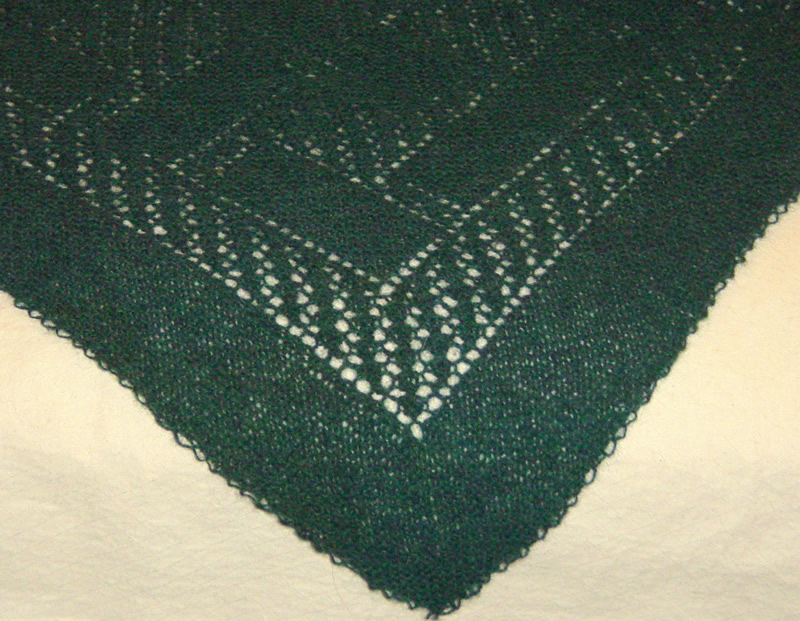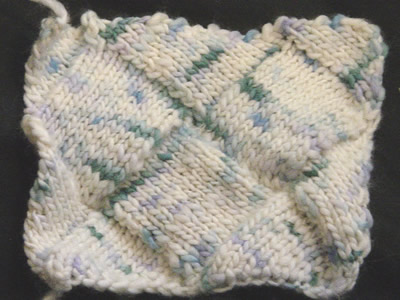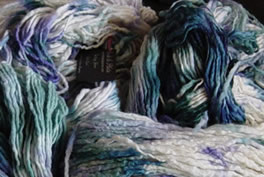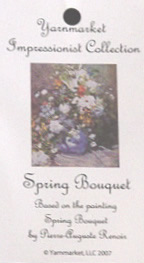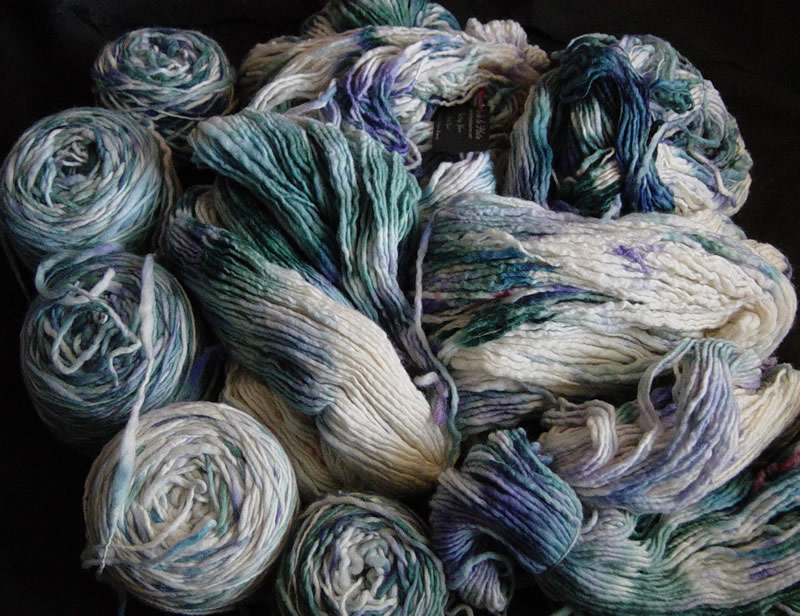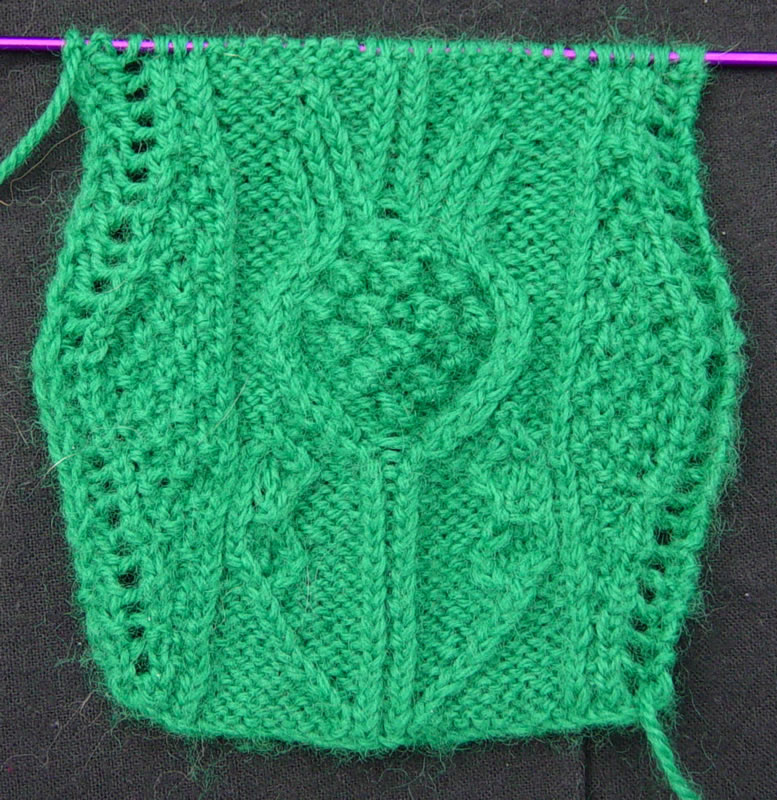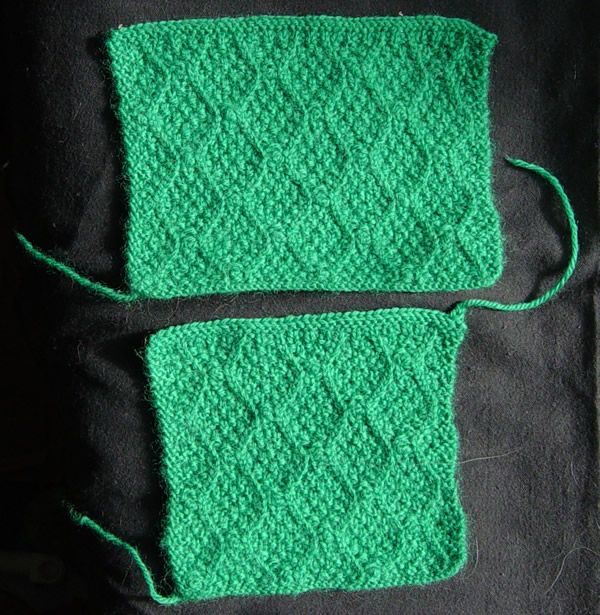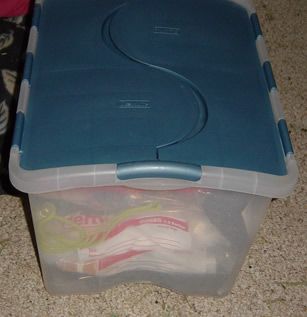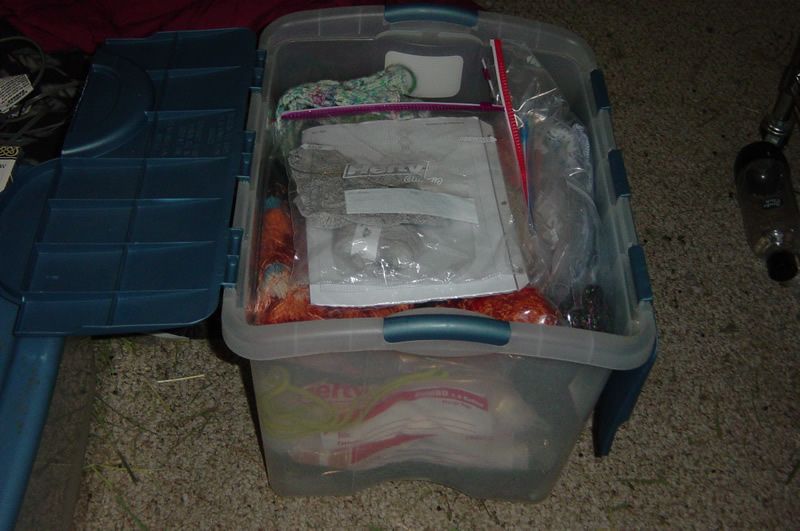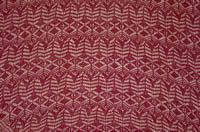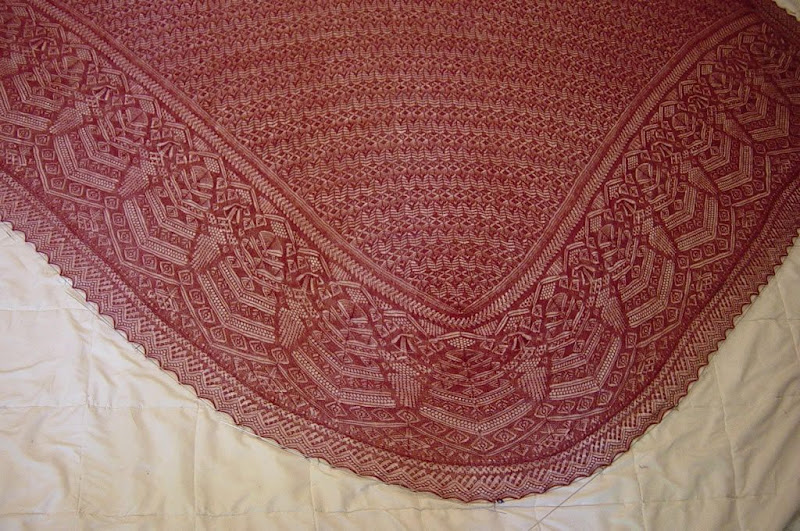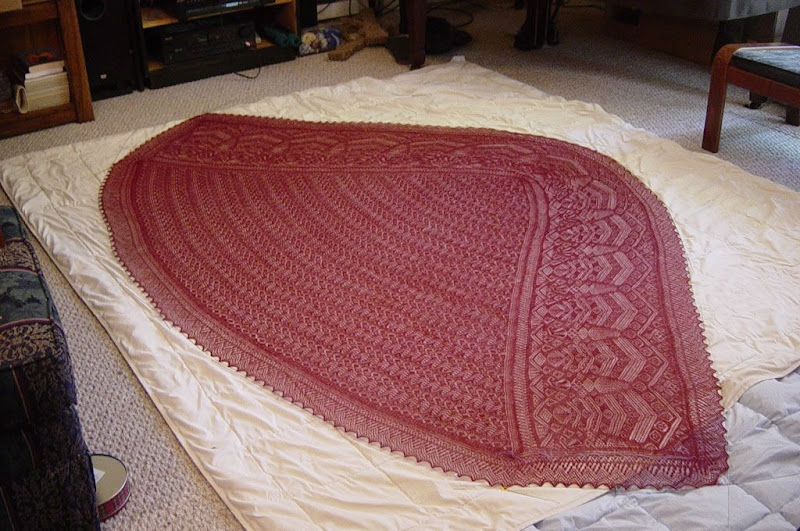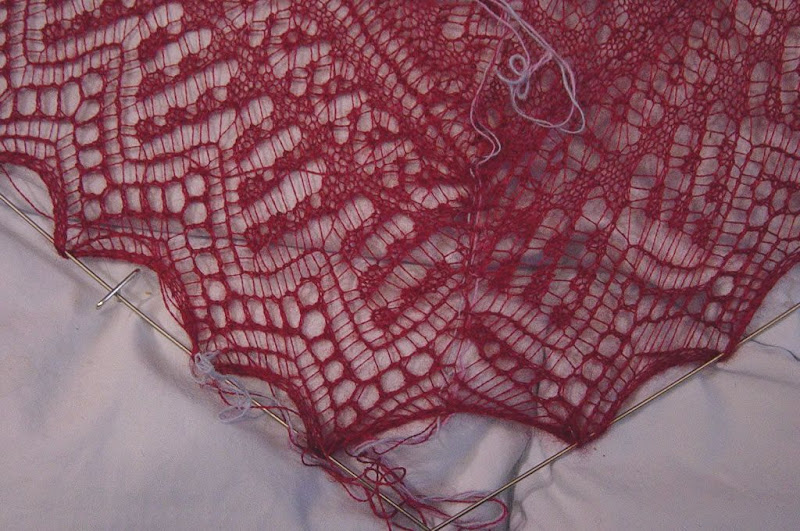[[ This post was supposed to appear last Friday, before it got hijacked by the image-handling crisis. Fortunately its contents did not come marked with an expiration date. ]]
The past few days have witnessed a momentary lull in needlework activity around here, because I've been so busy cavorting all over the Internet, exploring Ravelry & discovering new knitting blogs & online yarn retailers, that I have't done any real *knitting* to speak of. I'm also still waiting for my NatureSpun yarn for Peggy Tudor and a bunch of new patterns to arrive. Patience, patience.
Be that as it may, I still have a blog-worthy story to tell, in that a few days ago I finally came to grips with my untidy stash of yarn and sewing fabric. The reference in today's title to the famous archaeological site at Rancho La Brea in the Los Angeles area is by way of being (a) an hommage to Bugs Bunny, a childhood hero whom I distinctly remember mentioning the tar pits more than once, (b) a nod at the parallel universe where I became a paleontologist, and (c) a signal that we are talking here about personal ARCHAEOLOGY. Digging through layers and layers of my needlework history, rediscovering the past, clearing away mounds of debris, and getting more than a little bit dirty in the process.
Take a minute to savor the imagery. Tar is sticky. It oozes and occasionally makes a sound like "blorp". It adheres to any surface that happens to come into contact with it. It even grabs hold of defenseless animals and refuses to let go. If they cannot escape, they grow weaker and weaker until they eventually die, and their remains are sucked into the tar and preserved remarkably intact. For centuries. Millennia. Thousands of them. Future generations discover the vast deposit and build a glass enclosure around their field laboratory, so that tourists can come and watch the archaeologists at work as they uncover one fascinating specimen after another...
So this is about exploring my own personal tar pits. Call it "La Brea on the Ohio," if you will. And instead of ferocious saber-toothed tigers and dire wolves, the objects being unearthed in my little neck of the woods are skeins of yarn and pieces of fabric. Some of these are still whole and have never been touched since the day they were purchased, but there are also remnants, LOTS of remnants, from previous projects.
You will know whereof I speak, if you are a needlework person yourself, or have ever shared or even just visited a home where such a person lives. Stuff accumulates. For instance, see this recent blog post from a like-minded soul who recently went through a similar cleanup.
My stash notionally lives in a certain closet next to my sewing table, although in recent months it had begun slowly taking over the rest of the house. There were bags and boxes and bundles of yarn and fabric *EVERYWHERE*. It had finally reached a crisis point not long ago, and the need to remedy that situation and reclaim valuable real estate was a big part of why I decided to roll up my sleeves and launch a full-scale excavation.
Another factor, of course, was joining Ravelry. I hadn't taken an inventory of my stash in years! Going so far as to compile an itemized list of every yarn that I own and posting it on my Rav-profile is something that I know I won't get around to for a long time, if ever, but I was curious about what hidden gems I had tucked away and forgotten.
In addition, I am expecting the imminent arrival of a bunch of fabric from my mother's sewing stash. She moved into a retirement complex about a month ago, and although she took her sewing machine with her, she does not have storage space for much in the way of superfluous yard goods. So I am inheriting certain items that she acquired long ago and never used. Best to clear the decks and make room here *before* the onslaught.
I do not have a photo of what it all looked like before this process began, because it was just too depressing. I could not bring myself — nay, it did not even OCCUR to me to take any pictures. Why would anyone want to look? So, dear reader, I will do my best to describe what it was like, and you are simply going to have to use your imagination to fill in the rest.
I should say in my own defense that I had not neglected the need for organization altogether. Years ago, I had acquired several large(ish) stackable plastic bins which can hold a lot of stuff and sit neatly & unobtrusively in the closet most of the time. To do them credit, I have to say that they have done a pretty good job of keeping the stash contained and stopping it from taking over too much of our living space. But all the same there have been certain annoying and seemingly intractable problems...
First of all, the bins in question were opaque, which is splendid for preventing damage from sunlight, but absolutely hopeless from the standpoint of ever trying to find anything on demand. The operative verb is *rummage*. I would periodically go through and try to organize the contents in such a way as to keep the most frequently used items near the top of the pile (where I could theoretically get at them). More to the point, I would always relegate toward the bottom of the pile anything I felt reasonably certain I was not going to want anytime soon. But I could never for the life of me manage to remember what was where, which meant dismantling the closet and going through the entire stack, opening bin after bin in turn, practically every time I simply wanted to retrieve a particular skein or fabric sample.
It was a terribly clunky and inefficient system beyond a doubt, and on the not-too-frequent occasions when I actually had to dive in and try to hunt for anything from the stash, I would grumble and curse and tell myself that one of these days I should really find a better way of doing things. Such urges are infrequent, though, & quickly pass. I have a busy life, and the bins were managing to keep the chaos reasonably under control. So months and months and even years went by without me really either noticing or needing to take any immediate action.
Now go back to the tar pits idea and imagine something that starts out, innocently enough, as a collection of yarn that's mostly in bags, although some skeins are floating around loose, and fabric that's likewise either folded (if unused) or else in a bag of loose remnants. What happens when you rummage through that collection over and over and over again, for YEARS, and do not always put things back as neatly as they were when you found them?
Each time the stash is disturbed, items are displaced, reshuffled, and/or intermingled with the surrounding material, and then everything is allowed to settle again for a while. Repeat this process many, many times over an extended period, and the result is a unique form of multi-layered chaos. Every distinct layer has a discernable center of mass separating it from the others, but the boundaries between the layers become increasingly fuzzy and hard to identify. Slowly but surely, the situation devolves.
Add that to never-ending challenge of opaque bins, and you should have a fairly good idea of what I was facing last weekend as I screwed my courage to the sticking place (tar pits, remember?) and set myself to work.
I will try not to belabor the subsequent narrative, except to say that I...
(a) found some translucent bins that we already had and switched out their contents, which did not need to remain visible, so that my stash could take up residence in them,
(b) emptied the existing bins and bags and boxes and bundles, one by one, onto the bed, so that I could sort through things and (re)group any items that had gotten separated from their proper cousins,
(c) got rid of ~10,000 dingy & decrepit plastic and occasionally even paper bags (some literally dating back 20 years or more!!) that had been used to house stash items, and replaced them with lovely new clear ziploc-style ones, which I had bought in bulk in several different sizes,
(d) separated yarn from fabric and whole skeins/yardage from remnants in both categories, and finally,
(e) loaded the fabric into several long, flat bins (*ideal* for the purpose), and the yarn into several taller ones.
I needed about a day and a half to complete this complex task. It was completely CATHARTIC, and an enormous RELIEF to see the new system take shape.
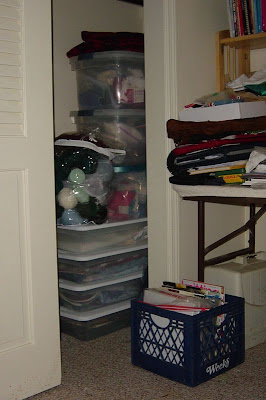
Here is a photo of the closet now, with the yarn bins stacked neatly on top of the fabric. You can also see the milk crate by the door with all my knitting magazines and loose patterns, which I had sorted through a few days earlier. I even put sticky notes on the cover of each magazine listing the projects that had caught my eye with their page #'s and a quick identifier. No more leafing through stacks of back issues in search of a particular pattern! *Grin*.
Oddly enough, I found out that I had accumulated rather less than I imagined. That was very reassuring, I must say, and useful for silencing any lingering guilt over purchases long past.
Going through all the old remnants brought back lots of fond memories too. Don't get me wrong: I have definitely had my share of unsuccessful projects over the years. But most of them are long gone, and I managed to salvage the good parts of the few that remained and get rid of the rest. So there's nothing left in my stash now that I can't honestly hope to use someday.
Or at least that's what I am going to keep telling myself. Hehehe.
Last but not least, I commandeered a special bin for my knitting WIP's. These have a pernicious tendency to sprawl and scatter themselves throughout the house, as any knitter knows, so I was delighted to come up with what I think will be a marvelous solution.
The bin in question has an attached lid in two halves that that swing open from hinges on either side and then interlock in the middle when closed. I can now get at the items that are on duty quickly and easily, without having to dismantle the whole long-term storage system to hunt down and retrieve them. It an amazing and wonderful feeling to have it all handy in one place, and to know that the bedroom and living room and study, etc. are now safe(r) for human habitation again.
That's the WIP bin neatly closed. See how cleverly the two halves of the lid interlock? And here is the same bin invitingly open. That's my Unst Stole right on top, with the Frejya sweater underneath. :-)
Makes you want to dive in & start knitting, doesn't it? And now I can sit as I do just that, while I gaze contentedly at my stash, thinking about past adventures and future possibilities. Mmmmm.... All that fuss was DEFINITELY *WORTH IT*.
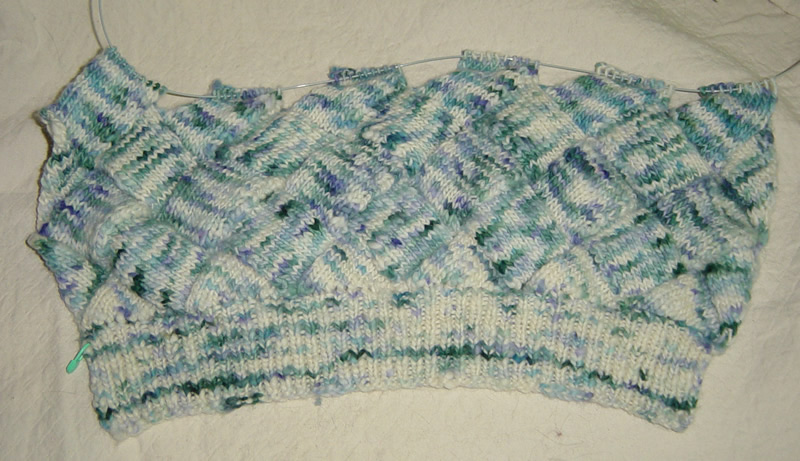

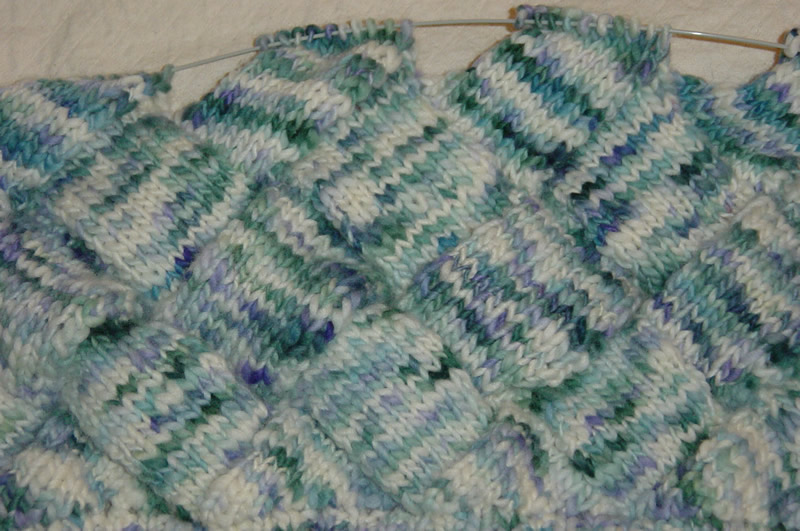
 My bounty was a 2-ply fingering weight Shetland wool in a rich heathery color that is a mixture of navy blue and forest green, almost as if somebody took the "Black Watch" tartan and ran it through a blender. I ran across a handful of remnants recently in the course of
My bounty was a 2-ply fingering weight Shetland wool in a rich heathery color that is a mixture of navy blue and forest green, almost as if somebody took the "Black Watch" tartan and ran it through a blender. I ran across a handful of remnants recently in the course of 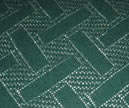 It's knitted from corner to corner, on the bias, with lace patterning only on the RS rows (you simply knit back on the WS). The original pattern is for a 58" square. You start with just 3 stitches and increase with a yo at the beginning of every row until the widest point, where you begin decreasing at the same rate until only 3 stitches are left again at the end. I worked out a way to make a rectangle instead, by inserting a parallelogram-shaped wedge in between the two corner triangles. For a while I was increasing on one side and decreasing on the other, thereby maintaining a consistent number of stitches at the maximum width before beginning the "real" decrease. So I was able to elongate the finished piece without disrupting the pattern.
It's knitted from corner to corner, on the bias, with lace patterning only on the RS rows (you simply knit back on the WS). The original pattern is for a 58" square. You start with just 3 stitches and increase with a yo at the beginning of every row until the widest point, where you begin decreasing at the same rate until only 3 stitches are left again at the end. I worked out a way to make a rectangle instead, by inserting a parallelogram-shaped wedge in between the two corner triangles. For a while I was increasing on one side and decreasing on the other, thereby maintaining a consistent number of stitches at the maximum width before beginning the "real" decrease. So I was able to elongate the finished piece without disrupting the pattern.
